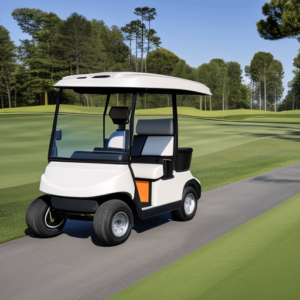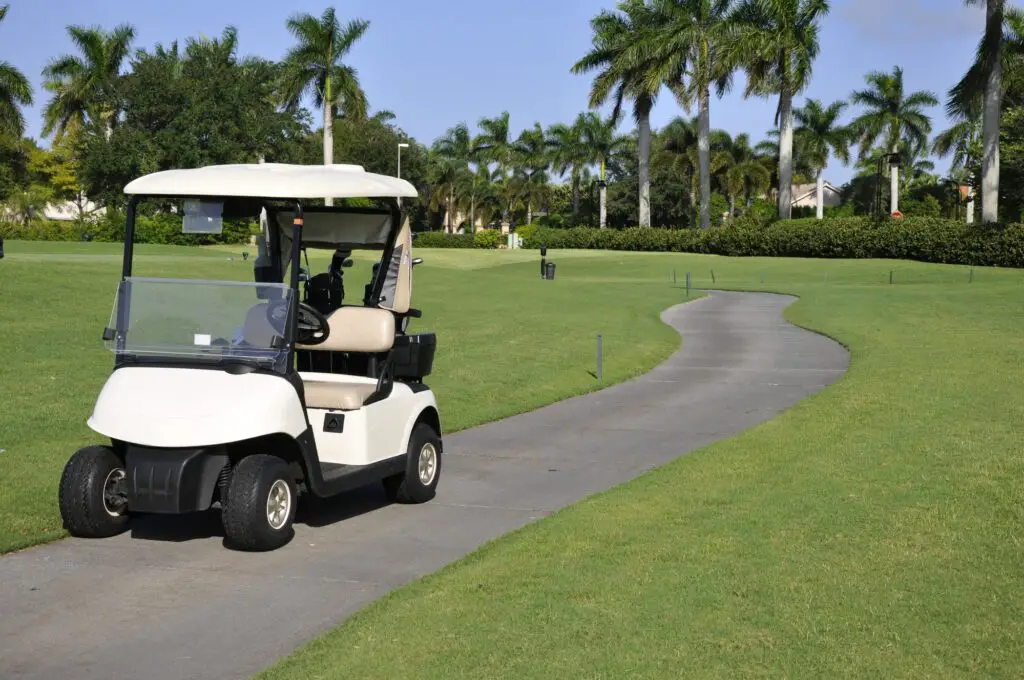Last Updated on October 16, 2023
Golf carts are the perfect way to get around on a golf course, but how fast do they go? It’s a critical inquiry for those wishing to exploit their time and capability. From acceleration speeds to top speeds, there is a lot that goes into understanding just how quickly your cart can move you from one hole to another. We’ll take a look at all of this in our exploration of “How fast do golf carts go?” So buckle up, and let’s explore the ins and outs of maximizing your golf cart speed.
Table of Contents:
- Maximizing Your Golf Cart Speed
- Golf Cart Acceleration
- Golf Cart Top Speeds
- Factors Affecting Golf Cart Speed
- Conclusion
Maximizing Your Golf Cart Speed
Golfing vehicles are a great solution for traversing the golf course with ease. Whether you’re playing a round of 18 or just heading out for a practice session, having the right golf cart can make all the difference in your game. But how can you maximize your golf cart speed?
The speed of a golf cart can range from 15 to 25 mph, depending on its power source (electric or gas) and size. If you have an electric model, it may reach speeds up to 25 mph with some modifications. Gas-powered carts typically go faster than electric ones but will require more maintenance due to their higher power output.
To increase your golf cart’s speed, consider adding larger tires that are designed for higher speeds and better grip on the terrain. This will help reduce drag from friction when travelling at high speeds and provide greater traction when cornering. For even more power, you could upgrade your motor to one with higher horsepower or switch from electric to gas-powered.
To enhance the speed of your electric model, install a speed sensor or adjust the maximum speed settings with a ‘speed chip’, as well as replacing older batteries with newer ones that offer better performance and longer life. You can install a speed sensor to give the motor a false sense of light load and make it run faster.
Finally, keep in mind that most street legal low-speed vehicles have limits imposed by law, so be sure to adhere to these restrictions when attempting to maximize your golf cart’s performance. With these tips in mind, you can now hit the green in style while enjoying every minute of it.
Maximizing your golf cart speed can be achieved through techniques like tuning the engine, upgrading the tires and wheels, and reducing weight. By understanding how acceleration works on a golf cart, you can make informed decisions to increase its performance.
Golf Cart Acceleration
Golf carts have become increasingly popular in recent years, and it’s easy to see why. They provide a convenient way to get around the golf course or even just your own backyard. To maximize the speed of your cart, you should be aware of certain factors.
First off, electric golf carts are usually faster than gas-powered ones. Electric motors tend to be more powerful and offer better acceleration than gasoline engines. However, they can also be much slower when going uphill due to their limited torque capabilities. That said, most electric models will reach speeds of up to 20 mph on flat terrain with no problem at all.
The size of the tires and the power of the motor are usually responsible for dictating the top speed achievable by a gas-powered golf cart. Larger tires allow for greater traction and, therefore, higher speeds while a powerful motor gives you more torque which translates into quicker acceleration times as well as higher top speeds overall. Gas-powered carts can generally reach speeds of up 30 mph or more, depending on how they’re set up.
Another factor that affects a golf cart’s speed is its battery life; electric models need regular charging in order for them to remain fast over time, whereas gas powered versions rely solely on fuel consumption rates instead. For a more potent performance, opt for the gas-powered variant; however, if you need extended battery life, then an electric model is your best bet.
Finally, there are some accessories that can help boost your cart’s performance, such as speed sensors or chips tailored for better acceleration and improved low-speed manoeuvrability akin to larger vehicles like SUVs and trucks – so bear these in mind.
In conclusion, whether you choose an electric or gas powered model, there are plenty of ways to maximize your golf cart’s speed without sacrificing safety along the way – from choosing larger tires with more grip or investing in additional parts like sensors and chips. Take advantage of these options today and enjoy zipping around your local courses in style.
Golf cart acceleration can vary depending on the type of golf cart and its motor, but typically they accelerate from 0 to 20 mph in around 10 seconds. To find out more about how fast golf carts go, we’ll now take a look at their top speeds.
Golf Cart Top Speeds
Golf carts are a key component of the sport, allowing for easy navigation around golf courses. But how fast can you go in a golf cart? Well, it depends on several factors like the type of motor, battery life, size of tires and even speed chips or sensors that some carts have.

Electric golf carts typically reach speeds between 10-15 mph, but there are faster models available. Gas-powered golf carts tend to have larger tires which allow them to reach higher top speeds up to 20 mph. Some manufacturers also offer street legally gas powered golf carts that can reach 25 mph if fitted with special parts such as longer batteries and a powerful motor.
The world’s fastest electric golf cart is believed to be able to reach 35mph, while a modified gas-powered model has been clocked at 60mph. However, these are not typical figures for either type of cart, as most average out at around 15mph for electric models and 20mph for gas powered ones.
If you want your golf cart to go faster than usual, then there are ways you can do this, such as fitting larger tires or installing speed chips or sensors, which will increase its maximum speed by about 5 mph each time. You should bear in mind, though, that doing so may reduce the battery life significantly, so it’s best only done if necessary. Additionally, some states restrict low-speed vehicles from going above certain speeds, so make sure you check local laws before making any modifications too quickly.
Overall, when it comes to getting your hands on a speedy ride around the course, then look no further than investing in an electric or gas-powered golf cart. Just remember, not everyone needs one capable of reaching top speeds – after all, slow and steady wins the race.
Golf cart top speeds can vary significantly depending on the model, terrain and other factors. Considering the various elements that can affect a golf cart’s speed, let us investigate some of these variables.
Factors Affecting Golf Cart Speed
Golf carts are a useful tool for zipping around the golf course quickly and efficiently. But what affects their speed? Knowing the factors that influence your cart’s speed can help you make adjustments to maximize your performance on the links.
The first factor is weight. The heavier your golf cart, the slower it will be, as more power is needed to move it. Make sure you don’t overload your cart with unnecessary items like extra clubs or bags of snacks; every ounce counts when it comes to speeding up.
Another factor influencing golf cart speed is terrain type. If you’re going uphill, expect a slower ride than if you were driving on flat ground. Additionally, grassy areas require more energy from the motor due to increased friction between tires and turf, so if you want to zip along at top speeds, stick to paved paths instead.
The third factor affecting golf cart speed is tire size and pressure. Bigger tires offer better traction but can slow down acceleration; smaller ones provide less grip but may give an edge in terms of speed when going straight ahead or downhill. Tire pressure also plays a role: too low and there won’t be enough contact with the ground for maximum acceleration, while too high will cause excessive wear and tear on both rubber and rims alike.
Finally, battery condition has an impact on how fast your golf cart moves –– especially over longer distances where sustained power output becomes essential for maintaining good speeds throughout each hole played without having to recharge mid-round. A fresh set of batteries should do wonders for getting those wheels spinning faster than ever before; just remember not to forget about them during maintenance checkups in order to ensure optimal performance out there on the course day after day.
Conclusion
Gaining insight into the velocity of a golf cart is not definite, yet comprehending how components such as landscape, weight capacity and motor type can affect its speed is essential. Ultimately, maximizing your golf cart speed comes down to understanding these variables and adjusting accordingly for optimal performance on the green.



